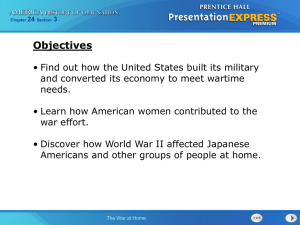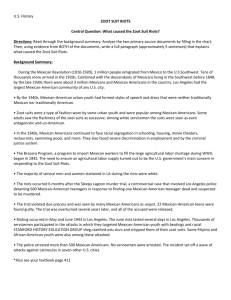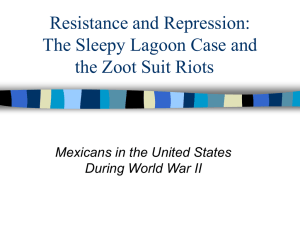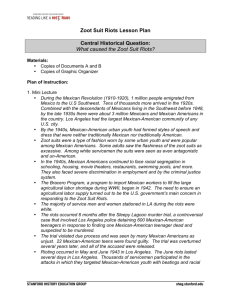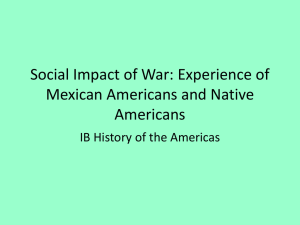What was root cause of the Zoot Suit Riots of 1943?
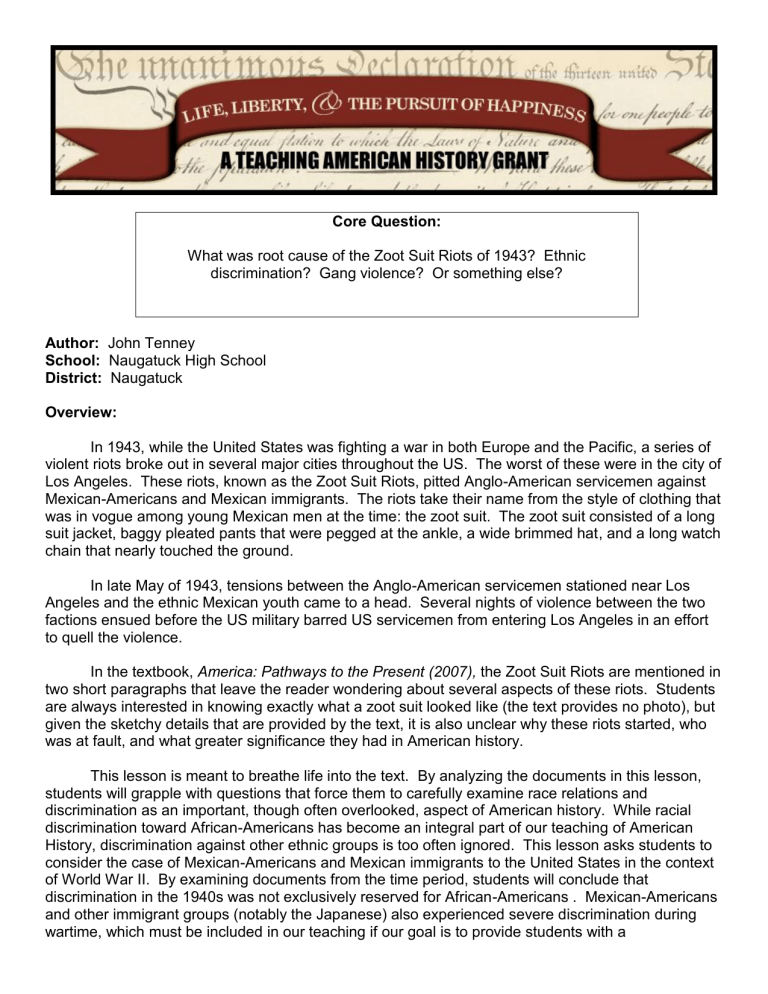
Core Question:
What was root cause of the Zoot Suit Riots of 1943? Ethnic discrimination? Gang violence? Or something else?
Author: John Tenney
School: Naugatuck High School
District: Naugatuck
Overview:
In 1943, while the United States was fighting a war in both Europe and the Pacific, a series of violent riots broke out in several major cities throughout the US. The worst of these were in the city of
Los Angeles. These riots, known as the Zoot Suit Riots, pitted Anglo-American servicemen against
Mexican-Americans and Mexican immigrants. The riots take their name from the style of clothing that was in vogue among young Mexican men at the time: the zoot suit. The zoot suit consisted of a long suit jacket, baggy pleated pants that were pegged at the ankle, a wide brimmed hat, and a long watch chain that nearly touched the ground.
In late May of 1943, tensions between the Anglo-American servicemen stationed near Los
Angeles and the ethnic Mexican youth came to a head. Several nights of violence between the two factions ensued before the US military barred US servicemen from entering Los Angeles in an effort to quell the violence.
In the textbook, America: Pathways to the Present (2007), the Zoot Suit Riots are mentioned in two short paragraphs that leave the reader wondering about several aspects of these riots. Students are always interested in knowing exactly what a zoot suit looked like (the text provides no photo), but given the sketchy details that are provided by the text, it is also unclear why these riots started, who was at fault, and what greater significance they had in American history.
This lesson is meant to breathe life into the text. By analyzing the documents in this lesson, students will grapple with questions that force them to carefully examine race relations and discrimination as an important, though often overlooked, aspect of American history. While racial discrimination toward African-Americans has become an integral part of our teaching of American
History, discrimination against other ethnic groups is too often ignored. This lesson asks students to consider the case of Mexican-Americans and Mexican immigrants to the United States in the context of World War II. By examining documents from the time period, students will conclude that discrimination in the 1940s was not exclusively reserved for African-Americans . Mexican-Americans and other immigrant groups (notably the Japanese) also experienced severe discrimination during wartime, which must be included in our teaching if our goal is to provide students with a
comprehensive overview of the history of this period.
Procedure:
1. The teacher will begin the lesson with a mini lecture on how various minority groups were impacted by World War II. The lecture will make mention of Japanese internment, Jim Crow laws, segregated armed forces, and the changing role of women. The teacher will ask if students are aware of how the war impacted any other minority groups in the United States.
2. In the student text ( America: Pathways to the Present ), the class will read together the section labeled “Mexican Americans” (p.857) and “The
Bracero
Program,” which together consist of a total of t wo paragraphs. Then the class will read the two paragraphs dedicated to the “Zoot
Suit Riots.”
3. The teacher will pose general questions about the experience of Mexican Americans during the War, leading students to begin to wonder why they received such cursory treatment in the text. The teacher will specifically ask about the Zoot Suit Riots, again, the questions will lead students to note that there must be a lot more to the story than the authors of the textbook decided to include. The teacher will ask students to speculate as to why the textbook authors only dedicated two paragraphs to the Zoot Suit Riots and only a total of four paragraphs to the experience of Mexican Americans and Mexican immigrants during this period.
4. With students primed and wanting to discover more about the Riots, the teacher will segue into the OUT activity.
Document Summary:
Document 1
This photo from the 1940s of three Mexicans dressed in zoot suits is meant to provide students with a visual reference. Naturally, students are curious about exactly what a zoot suit looked like. Students will be asked to compare the clothing and style of these zoot suiters with the clothing and style that was typical for members of the military at the time. While there is not a lot of information in this document that can point to a definitive answer to the core question, students will likely note the sharp contrast between the outward appearance of the two groups and the fact that their style of dress underlined the
“otherness” of the Mexican youths.
Document 2
This article from Time Magazine provides the student with a glimpse into the violence of the riots and how it was described to a national audience. It elaborates on the brief description found in the textbook. Students will be asked to detect biased language in this document. The tone of the article seems to celebrate the violence rather than simply report it or condemn it.
Document 3
This document is a letter from the Youth Committee for the Defense of Mexican American Youth to
Vice President of the United States Henry Wallace. It was written before the Zoot Suit Riots broke out which shows that there was perceived discrimination toward youth of Mexican decent well in advance of the violence. The document uses very simple language and is appealing for its child-like innocence. This document will be approachable for all students —even those with a very low reading level. Students will also find it easy to interpret and will likely be able to identify with it in some way because it was written by people close to their own age. This document clearly supports the argument for racial/ethnic discrimination as a root cause of the riots.
Document 4
This document is a statement made by the mayor of Los Angeles near the peak of the riots. The
Mexican government had contacted the State Department expressing concern over the riots and prevalence of racial discrimination against Mexicans. The State Department, in turn, contacted the mayor. In his statement, the mayor emphatically denies that racial discrimination is at the root of the riots. Taken at face value, the mayor’s statement supports the idea that the riots were not racially motivated but were instead the result of the violent activities of youth gangs. A careful reading of the document, however, will reveal signs of racial discrimination. In addition, the fact that the Mexican government would make a decision to voice concern over American domestic affairs in one of its major cities points to the seriousness of the issue from the point of view of the Mexican government.
Document 5
This document is primarily composed of excerpts from the committee that Governor Earl Warren appointed to investigate the root cause of the riots. It directly contradicts the previous document that states racial discrimination was not a core cause of the riots. It states that discrimination toward
Mexican Americans is indeed a problem and it is a problem that needs to be addressed. It also comments on general trends in juvenile delinquency, stating that while delinquency is on the rise for all ethnic groups, it has actually grown more slowly in the Mexican American community as compared with other communities. This is another strong piece of evidence that suggests the riots might not have been the result of increased violence and crime by Mexican American gangs, but racial discrimination stirred up by wartime xenophobia and a regrettable tradition of racism.
TEXTBOOK SELECTION
Excerpt from America: Pathways to the Present (2007), p. 858
DOCUMENT PACKET
Document 1
This photograph dates from the 1940s. The young Mexican men are wearing zoot suits. The zoot suit consisted of a very long jacket and baggy pants that were pegged at the ankle. “Zoot suiters” typically wore their hair slicked back in a “duck tail” style and sometimes wore a fedora style hat.
Source:
Photo: http://the-cali-dream.blogspot.com/2012/02/zoot-suit-riots.html
Document 2
This article appeared in Time Magazine in June 1943. It describes the “Zoot-Suit War” that took place in Los Angeles in late-May and early June for a national audience.
TIME MAGAZINE, JUNE 21, 1943
ZOOT-SUIT WAR
For two nights the mobs of soldiers and sailors had found poor hunting. In long caravans of cabs and private cars they had toured the Mexican sections, armed with sticks and weighted ropes, crashing into movie houses, looking for zoot-suited pachucos , the little Mexican-American youths. But they had found only a few dozen, and not all of them even wore zoot suits. They had broken the jaw of a
12-year-old boy. Said the boy, in the hospital:
“So our guys wear tight bottoms on their pants and those bums wear wide bottoms . Who the hell they fighting, Japs or us?”
One Panzer division of the cab-and-car attack had rolled down a Mexican district side street, past the rows of mean, ramshackle frame houses. But they had only found a few victims to beat. One of them was a 17-year-old Russian boy, Pete Nogikoss, talking on a street corner to two Mexicans. The
Mexicans fled. Pete stood still. The sailors beat him to the ground.
Scores of Mexican youths had been stripped of their pants (some of them on the stages of movie houses), beaten and then arrested by the Los Angeles police for “vagrancy” and “rioting.” (The police practice was to accompany the caravans in police cars, watch the beatings and then jail the victims.
Their orders apparently were to let the Shore Patrol and the Military Police handle the rioting sailors.
The service police were futile .)
Vocabulary
pachuco
—a derogatory term for Mexican youth wide bottoms —refers to the “bell bottom” pants worn by US sailors
Panzer division of the cab-and-car attack —refers to the fact that US sailors and marines traveled in caravans of taxicabs and cars in search of zoot suiters futile --useless
Source:
http://www.time.com/time/magazine/article/0,9171,766730,00.html
Document 3
The document below is a letter from the Youth Committee for the Defense of Mexican American
Youth to Vice President of the United States Henry Wallace. The letter is not dated, but was written in 1942, before the riots broke out. It makes reference to the Sleepy Lagoon murder in which 24
Mexican boys were accused of murder (many were convicted, but the convictions were reversed in
1944). The Sleepy Lagoon murder is considered a forerunner of the Zoot Suit Riots that would take place in late May and early June, 1943.
YOUTH COMMITTEE for the DEFENSE OF MEXICAN AMERICAN YOUTH
1700 East 22nd Street, Los Angeles (in care of Mrs. Telles)
Reginald Garcia, Chairman
Dora Baca, Vice Chairman
Frank Hermosillo, Secretary
Roger Cordona, Treasurer
Hon. Henry A. Wallace,
Vice President of the United States,
Washington, D.C.
Dear Mr. Wallace:
We are writing you this letter because we heard you speak on the 16th of September here in Los
Angeles, and we feel you should know about the bad situation facing us Mexican boys and girls and our whole Spanish-speaking community.
What you said on that day was the truth, and you made us all think and wonder why everything around us was different than it should be.
On the very day you spoke there were 24 Mexican American boys accused of first degree murder.
These 24 boys come from our neighborhood. In our neighborhood there are no recreation centers and the nearest movie is about a mile away. We have no place to play so the Police are always arresting us. That's why most of the boys on trial now have a record with the Police, from suspicion even up to robbery. A lot of the boys worked in Defense plants and have brothers in Australia fighting under Gen. MacArthur. Our folks work in some defense plants if they are citizens, but if they are not citizens they don't get jobs even though Mexico is in the war too. Our mothers and fathers would like to help in the Red Cross and Civilian Defense but they cannot because it's all in English. There is still a lot of discrimination in theaters and swimming pools and the Police are always arresting us and searching us by the hundreds when all we want to do is go into a dance or go swimming or just stand around and not bother anybody. They treat us like we are criminals just by being Mexicans or of
Mexican descent. The newspapers have made us look like criminals too. They make fun of zoot suits and use the word "Mexicans" like it was a dirty word.
We have talked about all this in our club and we think it is very bad for the war because it is against unity and divides us from the rest of the people. Also some Mexican Nazi papers are saying that we are not satisfied and that we are sabotaging the war. Also there are some people around here that use these things to say that Uncle Sam is no good.
We know that is not true and we also know that us Mexican-American boys and girls can do a lot of things to win the war if someone will give us a chance. We have got a Defense Club to help the 24 boys on trial and the way we are raising money for that is to collect scrap iron. That way we help the boys and also help the war and also prove that we are not any help to the Fifth Column .
Mr. Wallace, we know that you can help us. Please go and see Mr. Rockefeller and ask him to help us too. He can tell them to give us radio programs in Spanish to tell us how we can help. Also if the
Government would print up the speeches of you and President Roosevelt and President Avila
Camacho we would distribute them, if they are in Spanish so our folks could read them. There are a lot of things we could do and we will talk about them in our meetings.
Discrimination is what hurts the most, so help us with that particularly because discrimination is the thing that makes the other Americans divide from us. Maybe also you can ask the city to give us places to play. The other thing is to ask the Police to stop arresting us all the time and treat us like criminals because we are Mexican or of Mexican descent.
Mr. Wallace, you helped us very much with your speech on the 16th of September and we need your help more so we can grow up to be good American citizens and win the war.
We don't like Hitler or the Japanese either.
We thank you very much.
Respectfully
(signed)
Vocabulary
Fifth Column
—groups believed to be working within the United States to aid the
Germans and Japanese in their war with America
Source:
http://www.pbs.org/wgbh/amex/zoot/eng_filmmore/ps_youth.html
Document 4
The Zoot Suit Riots grew to a frenzy in early June of 1943 which drew the attention of the Mexican government. The Mexican government contacted the US State Department to voice its concerns over the riots. In this document, Mayor of Los Angeles Fletcher Bowron responds to the concerns of the Mexican government that were passed on to him from Washington, D.C.
NEW YORK TIMES, JUNE 10, 1943
NOT A RACE ISSUE, MAYOR SAYS
LOS ANGELES, June 9-There is no question of racial discrimination involved in the zoot-suit trouble here, Mayor Bowron told State Department officials in a telephonic conversation.
Following his conversation the Mayor issued a statement in which he said:
I have had a long-distance telephone conversation with the State Department in Washington relative to the local situation. I was advised that the Mexican Embassy had called the matter to the attention of the State Department upon the basis of a report received from the Mexican Consul in Los
Angeles.
I informed the State Department that assurances could be given to the Mexican Embassy that the occurrences in this city are not in any manner directed at Mexican citizens or even against persons of
Mexican descent. There is no question of racial discrimination involved.
We have here, unfortunately, a bad situation as the result of the formation and activities of youthful gangs, the members of which, probably to the extent of 98 per cent or more, were born right here in
Los Angeles. They are Los Angeles youth, and the problem is purely a local one.
We are going to see that members of the armed forces are not attacked. At the same time, we expect cooperation from officers of the Army and Navy to the extent that soldiers and sailors do not pile into
Los Angeles for the purpose of excitement and adventure and that they might consider a little fun by beating up young men whose appearance they do not like.
We propose to handle the situation in such a way that there will be no reason for protests on the part of the Mexican Government.
At the same time, I want to assure the people of Los Angeles that there will be no sidestepping and the situation will be vigorously handled. There are too many citizens in this community, some of them good-intentioned and a few whose intentions I question, who raise a hue and cry of racial discrimination or prejudice against a minority group ever time the Los Angeles police make arrests of members of gangs or groups working in unison. They all look alike to us, regardless of color and
length of their coats.
The police are going to do the job and I propose to back up the police.
Vocabulary
State Department —the department of the US government that is responsible for conducting official interactions and relations between the United States and foreign governments
Mexican Embassy —official headquarters of representatives of the Mexican government in the US
Mexican Consu l
—the official representative of the Mexican government stationed at the
Mexican Embassy in Los Angeles
Source:
http://research.pomona.edu/zootsuit/en/resources/newspaper-articles/not-a-race-issue/
Document 5
As the violent riots were brought to an end, a committee appointed by California Governor Earl
Warren investigated the root cause of the riots and issued a report that is excerpted in the document below.
NEW YORK TIMES, JUNE 13, 1943
LOS ANGELES GROUP INSISTS RIOTS HALT
By Lawrence E. Davies
LOS ANGELES, June 12 -
Punishment of the guilty in crimes of violence, “regardless of what clothes they wear, whether they be zoot suits, police, Army or Navy uniforms,” was demanded today by a
Citizens’ Committee appointed by Governor Earl Warren to investigate the Los Angeles outbreaks of the last ten days involving “zoos-suit” wearers and service men.
Working closely with Robert W. Kenny, State Attorney General, the committee, headed by Bishop
Joseph T. McGucken of the Catholic diocese here, declared that the streets of Los Angeles “must be made safe for service men as well as civilians, regardless of national origins.”
“The community as well as its visitors,” it stated, “must learn that no group has the right to take the law into its own hands.”
…
Virtual calm prevailed all over the county during the day after a caravan of fiftythree “zoot suiters” had driven past the City Hall with flags of truce fluttering from the jalopies . Captain Joe Reed of the
Police Department, after interviewing them, congratulated them on their frank attitude….
Race Prejudice Factor Cited
Governor Warren’s committee found it to be “significant” that most of the persons mistreated during the recent incidents in Los Angeles were either persons of Mexican descent or Negroes.
“In undertaking to deal with the cause of these outbreaks,” its report said, “the existence of race prejudice cannot be ignored.
“Youth is peculiarly sensitive. To be rejected by the community may throw the youth upon evil companions.
“Any solution of the problems involves among other things an educational program throughout the community designed to combat race prejudice in all its forms.”. . .
[The committee] asked for additional facilities for the care and study of delinquent youth and described the problem as “one of American youth, not confined to any racial group.”
“The wearers of zoot suits,” the report went on, “are not necessarily persons of Mexican descent, criminals or juveniles. Many young people today wear zoot suits.
“It is a mistake in fact and an aggravating practice to link the phrase ‘zoos suit’ with the report of a crime. Repeated reports of this character tend to inflame public opinion on false premises and excite further o utbreaks.”
Rise in Juvenile Delinquency
“All juvenile delinquency has increased recently in Los Angeles. This includes crimes committed by youths of Mexican origin. But the fact is that the increase of delinquency in the case of youths of
Mexican families has been less than in the case of other national or racial groups and less than the average increase for the community.
“Between 1914 and 1929 all of California, and Los Angeles County in particular, had a rapid increase in Mexican population. The tremendous difficulties experienced by immigrants in making adjustments to their new surroundings are well known. We have learned that the problem is especially acute in the case of the second generation . The foreign-born parent loses authority over his American-born child; families tend to be broken up; and if the children are not completely accepted by their
neighbors; they are often without responsible guidance.
“These facts shed light on the youths of Mexican descent in Los Angeles. Many of them are second generation. About 98 per cent of them are American born.
“Of the serious crimes committed by persons of Mexican descent, only 25 per cent are committed by minors. Most of the socalled ‘zoos-suit’ crime amounting to felony has been committed by persons who are fully and legally responsible for their acts.”
Vocabulary
jalopie
—car acute —severe second generation —the children of parents who immigrated to US. These children were born in the US.
Source:
http://research.pomona.edu/zootsuit/en/resources/newspaper-articles/ny-times-l-agroup-insists-riots-halt/
Some of the language and phrasing in these documents has been modified from the originals.
CAPTURE SHEET
What was root cause of the Zoot Suit Riots of 1943? Ethnic discrimination? Gang violence? Or something else?
Answer the questions pertaining to each document. Use the information you gather to respond to the essential question above.
Document 1
1. Imagine the clothing and hairstyles worn by American servicemen during the 1940s. How do they compare with the clothing and hairstyles worn by the three Mexican American youths in this photo?
2. Do you think that sharply differing styles of dress can contribute to tensions between groups of young people? Explain.
Document 2
1. This document attempts to report the “Zoot Suit Riots” to a national audience. Read the document carefully. Do you detect any language that is biased?
Examples of biased language against Mexicans Examples of biased language against US servicemen
Document 3
1. This document is written by members of the Youth Committee for the Defense of Mexican
American Youth and is addressed to the Vice President of the United States. It was written before the riots broke out. Identify the concerns that the youth identify as well as the actions that they want the Vice President to take.
Concerns or complaints identified by the
Mexican American youth
Actions that they would like to see taken
2.
Do the writers’ concerns seem genuine to you? Cite specific evidence that supports your opinion.
Document 4
1. In this document, the mayor of Los Angeles denies that racial discrimination is a factor in the riots. Based on your own reading of the statement, do you believe him? Cite specific factors that make his statement believable or not.
Factors that make the mayor’s statement believable
Factors the make me question the truthfulness of the mayor’s statement
Document 5
1. Identify factors in this report that point to racial discrimination as a root cause of the riots.
Identify factors that point to causes other than racial discrimination.
Factors supporting racial discrimination as a root cause of the riots
Factors supporting factors OTHER than racial discrimination as a root cause of the riots
2.
How do you think this report compares with the mayor’s statement in Document 4? Do you think that one account might be more truthful than the other? Why?
Consider the analysis of the documents that you have just completed as you respond to the core question. Be sure to support your answer with evidence from the documents.
What was root cause of the Zoot Suit Riots of 1943? Ethnic discrimination? Gang violence?
Or something else?
Rubric for Analysis of Documents 1-5
Points
3
2 document.
Analysis is, for the most part, logical, historically sound, and is supported by some evidence from the document.
Descriptor
Analysis is logical, historically sound, and richly supported by specific evidence from the
1
0
Analysis lacks logic, historical soundness, and support from the document.
The student did not attempt to analyze the document.
Rubric for Answer to Core Question
Points Descriptor
3 The response is well constructed and makes a convincing argument, including rich supporting evidence from the documents, for the position taken.
2
1
0
Score Sheet
Document 1
The response is reasonably well constructed and makes a somewhat convincing argument, including some supporting evidence from the documents, for the position taken.
The response is poorly constructed and a convincing argument is lacking. There is little supporting evidence from the documents.
The student did not attempt a response to the core question.
/3
Document 2 /3
Document 3
Document 4
/3
/3
Document 5 /3
Core Question /3
(Doc 1) + (Doc 2) + (Doc 3) + (Doc 4) + (Doc 5) + 3(core question)= _______/28
